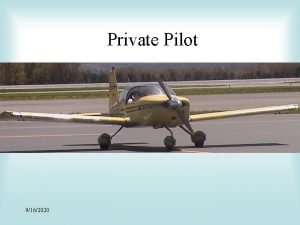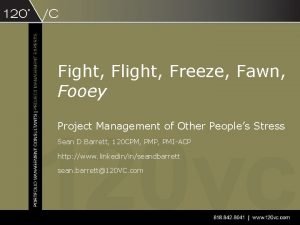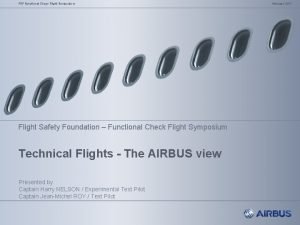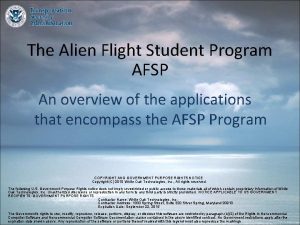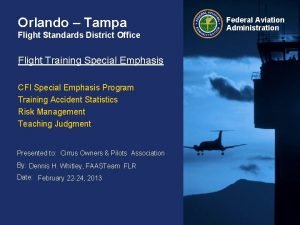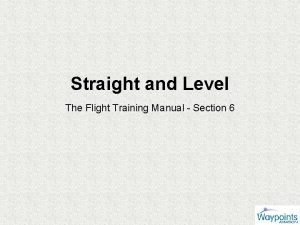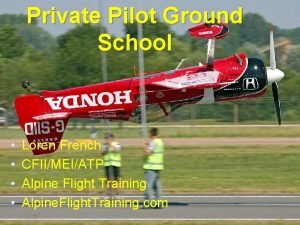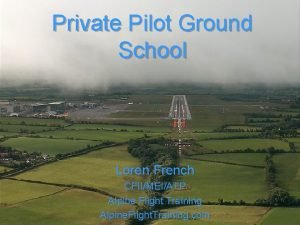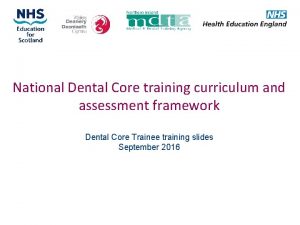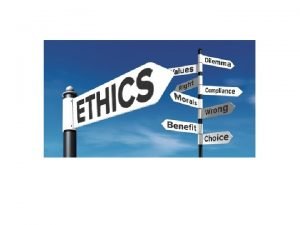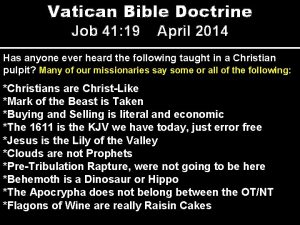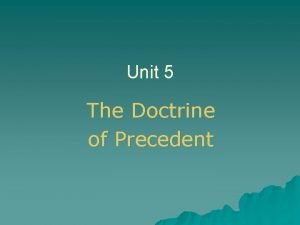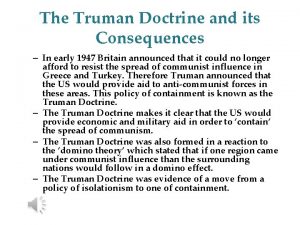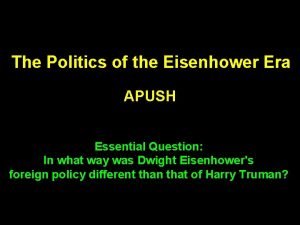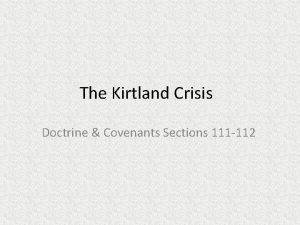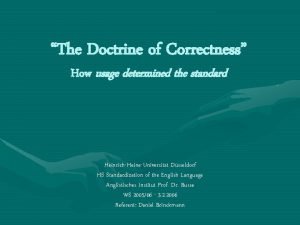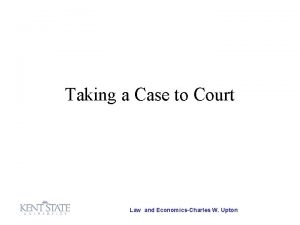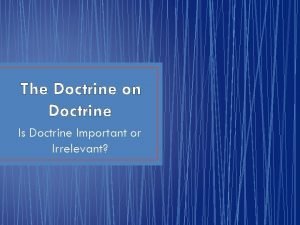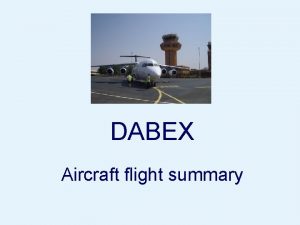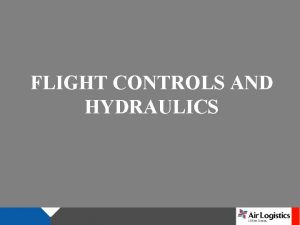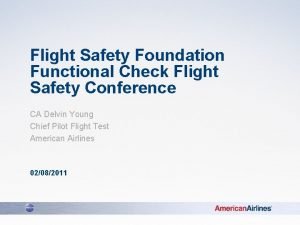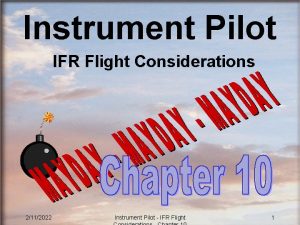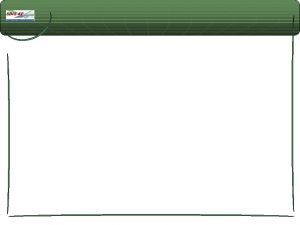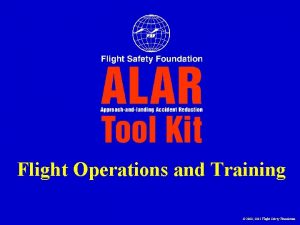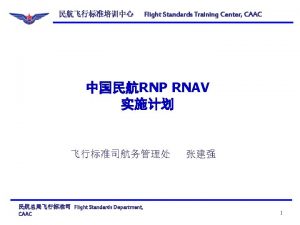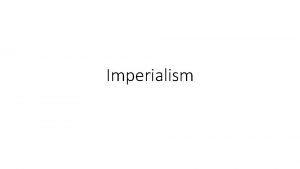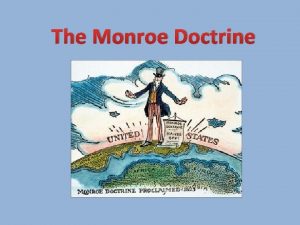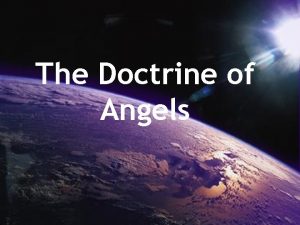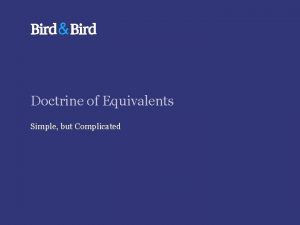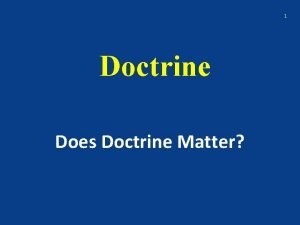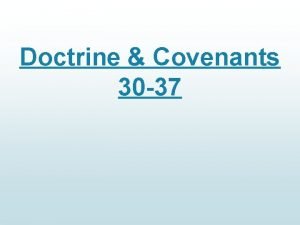FLIGHT TRAINING DOCTRINE THE FOUNDATION OF PILOT TRAINING
































































- Slides: 64

FLIGHT TRAINING DOCTRINE: THE FOUNDATION OF PILOT TRAINING REFORM

Elements of the Pilot Training System The Framework of Pilot Training Reform 2

The Issues Requiring Pilot Training Reform • Safety – Stagnant fatal accident rate for last decade – Risk management impact on fatal accident rate – Public image/latent training market 3

Issues Requiring Reform (continued) • Growing the community – Creating a more welcoming training environment – Providing more support for those learning to fly – Creating easier stepping stones – Using modern teaching tools and methods 4

The Components of the Pilot Training Delivery System • • Doctrine Standards Curricula Instructors and Schools 5

The Components of the Pilot Training Delivery System • Doctrine – The “what” and the “why” of the training system – Official training doctrine contained in FAA Handbooks and other documents – Supported and supplemented by industry doctrine • Manufacturers • Courseware providers • Training providers 6

The Components of the Pilot Training Delivery System • Standards – Knowledge tests and practical test standards (PTS) – Under current training philosophy, defines what is taught for pilot certificates and ratings – Issued by FAA, with some industry input 7

The Components of the Pilot Training Delivery System • Curricula – The “when”, “where”, and “how” of pilot training – Physical infrastructure and components – Syllabus – Training methods – Training tools 8

The Components of the Pilot Training Delivery System • Curricula (continued) – Defines the training environment • Classroom vs. distance learning (web, etc. ) • Simulators and training devices vs. aircraft – Defines the training method • scenario-based vs. maneuver-based • student-centered vs. instructor-centered – Developed by industry, rather than FAA 9

The Components of the Pilot Training Delivery System • Instructors and schools – The “who” of pilot training and the face of the training system to the customer – The integrators of the pilot training process – Critical to safety, student pilot starts and retention 10

The Components of the Pilot Training Delivery System • Instructors and schools (continued) – Instructors certified by FAA – School oversight by FAA varies • Training centers (Part 142) and Pilot Schools (Part 141) subject to FAA oversight on curricula but entities operating under Part 61 are not – Professional accreditation not widespread – Example: 90, 000+ flight instructors, only 600 Master Instructors 11

FAA Regulations • The FAA pilot training regulations set the boundaries of the pilot training system but do not define its content or application • Regulations and rule-making process lengthy and uncertain - Process can take ten years, end to end - Final rule requires implementing action 12

FAA Doctrine and Standards • Doctrine and standards are issued by FAA administratively, rather than through the rulemaking process – Standards are enforceable, and can be revised fairly easily – Rulemaking is complex and takes years, or even decades – FAA’s recent emphasis on general aviation safety focuses on non-rulemaking initiatives 13

This Symposium’s Challenge • Determine needed changes in training doctrine, standards, curricula, and instruction – Reduce fatal accident rate – Make training system more appealing and accessible • Craft recommendations for FAA and industry • Engage FAA and industry decision makers to improve the training system 14


Flight Training Doctrine – The Foundation of Pilot Training Reform 16

What is flight training doctrine? • “The formal description of knowledge, skills, and abilities that pilots must apply in order to safely and efficiently operate aircraft, including the rationale for prescribing these requirements” • The “what” and the “why” of pilot training requirements 17

Doctrine Purposes • Defining the minimum, desired, and/or optimum requirements to perform the aircraft mission specified • Standardizing performance expectations, both for the individual and the community • Providing a body of knowledge, skills, abilities, and procedures upon which to base knowledge and practical test requirements 18

Origins of Pilot Training Doctrine • Before 1939: Formalized mostly for airlines and military only – General aviation not well defined before then • AOPA formed 1939 • J-3 Cub introduced 1938 – Formal doctrine did not exist • Informal non-public training material • “Tribal” knowledge passed down 19

Origins of Pilot Training Doctrine • 1939 -1941: Civilian Pilot Training Program – First formal training doctrine for general aviation – Codified by CAA (ex. - Civil Pilot Training Manual) – Driven by looming military requirements • CPTP created doctrine – Example: Civil Pilot Training Manual (CAA Bulletin 23, 1940 -41) 20

Origins of Pilot Training Doctrine • 1939 -1941: Civilian Pilot Training Program – Structure for training process defined • Maneuver-based (rather than scenario or mission) • Driven by test (knowledge and practical tests) • Top down (rote, “spoon fed” by instructor) – Despite some improvements, still largely the model today 21

Who creates pilot training doctrine? • Original doctrine development (1939 -1941) – Largely influenced by looming military needs – Some input from CAA and training community • Today’s doctrine developers – FAA is custodian for documents, but – Industry playing increasing role • Ex. – FAA/industry General Aviation Joint Steering Committee (GAJSC) 22

Pilot Training Doctrine Examples. FAA Issued • FAA issued legacy handbooks – Airplane Flying Handbook – Aviation Instructor’s Handbook • New training topics – Risk Management Handbook – Advanced Avionics Handbook 23

Pilot Training Doctrine Examples. Industry Developed • Industry developed training doctrine – Manufacturers – Courseware developers – Training providers 24

How training doctrine is created • Doctrine is created by FAA with increasing industry input • Doctrine can be issued administratively – Usually with public notice – Time frame: Months to one or two years • Regulatory change requires elaborate procedures – Time frame: Years to decades 25

Doctrine vs. Regulatory Change • Regulations are basis for doctrine but do not determine actual content • Example: – 61. 107 Flight proficiency (private pilot) • 61. 107(b)(1)(v) “Performance maneuvers” – Airplane Flying Handbook (FAA-H-8083 -3 A) • Chapter 9 Performance Maneuvers – Steep turns – Chandelles 26

Key Players in Doctrine Development • FAA Headquarters (AFS-800 and AFS-600) • FAA/Industry Safety Groups (GAJSC) • Research community (Center for General Aviation Research – CGAR) • Industry – Manufacturers – Courseware providers – Others 27

Recent Progress in Doctrine Development and Revision • Many FAA handbooks have been reissued – Example: Instrument Flying Handbook • New FAA handbooks have been created – Example: Risk Management Handbook 28

Recent Progress in Doctrine Development and Revision • Despite recent progress, key questions remain: – Has new doctrine been effectively integrated into curricula and testing standards? – Are pilots using the new doctrine in flight operations? 29

Some other questions to ask • Is there any research to support the need for, and effectiveness of, revised training doctrine? – Previous research available? – Research currently underway? – Additional research needed? – Who will sponsor? 30

Some other questions to ask • How can FAA and industry move forward from here to ensure that doctrine is up to date and is effectively applied in training and in pilot flight operations? – How can industry and FAA collaborate? – Is there a current process we can use? 31

Some other questions to ask • Can manufacturers, and courseware and training providers, develop and implement effective training doctrine? – Which industry elements are best equipped to develop doctrine? – Are there alliances of manufacturers and training providers that are already doing this? 32


Research Supporting Modernized Training Doctrine Michele Summers Halleran

Center of Excellence for General Aviation Research – CGAR was established in 2001. CGAR’s mission is to utilize the world-class talents of our General Aviation Consortium members to make significant contributions toward improvements in safety and efficiency for General Aviation air transportation. CGAR accomplishes its goals with multidisciplinary teams to enhance aviation related research, education, technology transfer, and the utilization of research in mission critical areas.

Center of Excellence for General Aviation Research – CGAR The Center of Excellence for General Aviation Research is a research organization in a consortium of academia, industry, and government that addresses the needs of General Aviation through its synergistic relationships. • • Embry-Riddle Aeronautical University of Alaska University of North Dakota Wichita State University – Affiliate Members • Florida A&M University • Middle Tennessee State University Sponsored by the Office of Airport and Aircraft Safety R&D Division

FAA Industry Training Standards – FITS Develop a Methodology to Justify the Inclusion or Removal of Maneuvers from the Practical Test Standards Summary of Findings and Recommendations to the FAA Methodology for Validation of Tasks and Completion Standards Results of Initial Validation of Tasks and Completion Standards Effectiveness of FITS Training Embry Riddle Aeronautical University (ERAU) Study University of North Dakota (UND) Study Middle Tennessee State University (MTSU) Research MTSU Initial FITS Results Implementation of the FITS Program in TAAs: Lessons Learned Best Evidence for the FITS Program in TAAs FITS Enhances GPS Proficiency FITS Commercial Pilot Training Course – A Student’s Perspective Guide for Instructors and Examiners-Evaluating Pilots Using a Scenario-Based Methodology

FAA Industry Training Standards – FITS General Aviation Technically Advance Aircraft Safety Study Scenario Based training to teach Single Pilot Resource Management Examining Learner Centered Grading Scenario Based Training in TAA to Improve Risk Management Student Pilot Situational Awareness: The Effects of Trust in Technology Evaluating the Satisfaction and Quality of FITS Flight Training Evaluating the Effectiveness of Scenario Based Training in the Collegiate Flight Training Environment Validity and Reliability of Learner Centered and Collaborative Grading Determining Appropriate Levels of Automation Runway Incursion and Wrong Runway Threat and Error Management Syllabus

Current CGAR Research Projects Embry-Riddle Aeronautical University • Remote Airfield Lighting Systems • A Database Management System for General Aviation Safety • Pilot Awareness of Current and LED Elevated Runway Guard Lighting • Flight Data Monitoring: General Aviation Safety Information Analysis & Sharing • Weather in the Cockpit: Pilot Training Requirements • Synthetic Speech and Visual Data Communications for Flight Deck Use (Contract) • Pilot Source Study, Phase III University of Alaska - Anchorage • Remote Airport Lighting Systems III • Weather Technology in the Cockpit: CONOPS University of North Dakota • Weather in the Cockpit: User Needs Statement • Business Jet Loads Data Acquisition • Development of UAS Operational Data Collection Concept • Subject Matter Expert Support for FAA UAS Simulator Workstation • Helicopter Lighting System • FDM – GASIA & Sharing Phase I • Weather in the Cockpit: User Needs Statement

2010 CGAR Research Projects Embry-Riddle Aeronautical University • FITS Runway Incursion and Wrong Runway Threat and Error Management Syllabus • Data Communications Human Factor Air Traffic Control Implications on Preferential Treatment Service-for-Equipage University of Alaska – Anchorage • Visual Guidance - Remote Airfield Lighting University of North Dakota • Operational Loads Monitoring of Agricultural Aircraft • Analysis of 14 CFR Part 61 for Pilot, Flight Instructor and Ground Instructor Certification for Unmanned Aerial Systems • Analysis of 14 CFR Parts 91 & 43 for UAS Applications Wichita State University • Load Spectrum Development for Unmanned Aerial Systems Airworthiness

For More Information • http: //www. cgar. org • http: //faasafety. gov/ • http: //www. faa. gov/training_testing/training/ fits/

QUESTIONS ? • • • Michele Summers Halleran Embry-Riddle Aeronautical University Aeronautical Science Department Daytona Beach, FL (386) 226 -7020 Michele. Halleran@erau. edu


Jens Hennig Vice-President Operations General Aviation Manufacturers Association


Creating Industry Training Doctrine to Improve Flight Safety Travis Klumb Cirrus Aircraft

Cirrus Aircraft Flight Standards Office • SMEs and Flight Instructors – – – Transition training Corporate flight operations Aircraft delivery Training network oversight Flying club Courseware and document creation • Close interaction with entire company – – Engineers Flight Test Pilots Technical Publications Vendors

Cirrus aircraft are built on a foundation of safety features, but there is a common weak link WHY DO WE EXIST?

Always Trust Your Instruments, Son

Cirrus Flight Training • The pilot is still by far the weakest link – Stick and rudder skills – Avionics/automation proficiency – Behavioral issues • Hazardous attitudes / risk management • Standardization is our philosophy – Same procedures taught by all Cirrus instructors • Factory Instructors, CSIPs, CTCs – Same procedures flown by all Cirrus pilots

Standardization Emphasis Areas Standardized Instructors • Factory Instructors • CSIPs / CTCs Standardized Procedures • Flight Operations Manuals • Instructor Edition FOMs Standardized Training • Initial Training • Transition & Differences Training • Recurrent Training

STANDARDIZED INSTRUCTION

Cirrus Standardized Instructor Pilot • Foundation of standardized flight training in Cirrus aircraft • Provide experienced CFII’s in-depth knowledge of aircraft systems, flying qualities, and teaching techniques • Promote standardized flying among as many Cirrus pilots as possible • Recognized by most insurance underwriters – Program has helped reduce premiums & increase insurability

CSIP Program • Each instructor personally trained by Cirrus Aircraft Instructors – We think of the training as a mini type-rating – 450 current and active CSIPs – 1500 instructors have gone through the training • CSIP must renew certification annually – Online quizzing, flight with Cirrus instructor or very experienced CSIP

STANDARDIZED PROCEDURES

Flight Operations Manuals • Primary standardization document – Pilot and Instructor Editions – Normal, abnormal, emergency procedures – Flow patterns, profiles, expanded checklists – Desired outcomes, common errors, teaching techniques

Flight Operations Manuals • Guide for all Cirrus pilots on how to fly Cirrus aircraft • Available for free to anyone at Cirrus. Aircraft. com • Standardization concepts will be key to operating more complex aircraft such as the SF 50 • Used as common “Bible” for Cirrus flying and training – Cirrus Instructors, CSIPs, CTCs, CPPP Instructors – Very useful to avoid channel conflict and to quickly resolve technique disputes among pilots

STANDARDIZED TRAINING

Cirrus Transition Training • Complimentary with aircraft purchase – Evolved through the years with the airplane – Various training providers – 1→ 2→ 3 days of training • Extensive pre-training, ground, and flight training • Performance-based – Not everyone passes or progresses at same rate • Flexible and customizable, yet highly standardized

Transition Syllabus Suite • Training plan for Cirrus pilots • Transition and differences training • Recurrent training plan • Maximum flexibility while maintaining standardization – Weather delays, en-route training, advanced training

Access to Flight • Combined Private Pilot Certificate and Instrument Rating • Dr. Paul Craig of MTSU, ASA, Cirrus Flight Standards • Heavily based in FITS concepts • Scenario-based training from the beginning • Awaiting rulemaking change to allow simultaneous check ride

Additional Ways Cirrus Influences Training Doctrine • Cirrus Partner Symposium • Training Webinars • COPA (Cirrus type group) programs – Cirrus Pilot Proficiency Program (CPPP) – Critical Decision Making Courses (CDM)


LUNCH
 Private pilot limitations and privileges
Private pilot limitations and privileges Sutterhe
Sutterhe Functional check flight checklist
Functional check flight checklist Pad foundation
Pad foundation Composition of urine slideshare
Composition of urine slideshare Alien flight student
Alien flight student Tampa fsdo office
Tampa fsdo office Aeroplane flight training manual
Aeroplane flight training manual Alpine flight training
Alpine flight training Flighthub check in
Flighthub check in Slipstream
Slipstream Hát kết hợp bộ gõ cơ thể
Hát kết hợp bộ gõ cơ thể Ng-html
Ng-html Bổ thể
Bổ thể Tỉ lệ cơ thể trẻ em
Tỉ lệ cơ thể trẻ em Chó sói
Chó sói Tư thế worm breton
Tư thế worm breton Bài hát chúa yêu trần thế alleluia
Bài hát chúa yêu trần thế alleluia Các môn thể thao bắt đầu bằng tiếng đua
Các môn thể thao bắt đầu bằng tiếng đua Thế nào là hệ số cao nhất
Thế nào là hệ số cao nhất Các châu lục và đại dương trên thế giới
Các châu lục và đại dương trên thế giới Công thức tiính động năng
Công thức tiính động năng Trời xanh đây là của chúng ta thể thơ
Trời xanh đây là của chúng ta thể thơ Mật thư anh em như thể tay chân
Mật thư anh em như thể tay chân 101012 bằng
101012 bằng độ dài liên kết
độ dài liên kết Các châu lục và đại dương trên thế giới
Các châu lục và đại dương trên thế giới Thơ thất ngôn tứ tuyệt đường luật
Thơ thất ngôn tứ tuyệt đường luật Quá trình desamine hóa có thể tạo ra
Quá trình desamine hóa có thể tạo ra Một số thể thơ truyền thống
Một số thể thơ truyền thống Cái miệng nó xinh thế chỉ nói điều hay thôi
Cái miệng nó xinh thế chỉ nói điều hay thôi Vẽ hình chiếu vuông góc của vật thể sau
Vẽ hình chiếu vuông góc của vật thể sau Nguyên nhân của sự mỏi cơ sinh 8
Nguyên nhân của sự mỏi cơ sinh 8 đặc điểm cơ thể của người tối cổ
đặc điểm cơ thể của người tối cổ Giọng cùng tên là
Giọng cùng tên là Vẽ hình chiếu đứng bằng cạnh của vật thể
Vẽ hình chiếu đứng bằng cạnh của vật thể Vẽ hình chiếu vuông góc của vật thể sau
Vẽ hình chiếu vuông góc của vật thể sau Thẻ vin
Thẻ vin đại từ thay thế
đại từ thay thế điện thế nghỉ
điện thế nghỉ Tư thế ngồi viết
Tư thế ngồi viết Diễn thế sinh thái là
Diễn thế sinh thái là Dot
Dot So nguyen to
So nguyen to Tư thế ngồi viết
Tư thế ngồi viết Lời thề hippocrates
Lời thề hippocrates Thiếu nhi thế giới liên hoan
Thiếu nhi thế giới liên hoan ưu thế lai là gì
ưu thế lai là gì Hổ sinh sản vào mùa nào
Hổ sinh sản vào mùa nào Sự nuôi và dạy con của hươu
Sự nuôi và dạy con của hươu Sơ đồ cơ thể người
Sơ đồ cơ thể người Từ ngữ thể hiện lòng nhân hậu
Từ ngữ thể hiện lòng nhân hậu Thế nào là mạng điện lắp đặt kiểu nổi
Thế nào là mạng điện lắp đặt kiểu nổi Dental foundation training curriculum
Dental foundation training curriculum Doctrine of double effect examples
Doctrine of double effect examples Doctrine emplois
Doctrine emplois Hierarchy of uk courts
Hierarchy of uk courts Monroe doctrine political cartoon meaning
Monroe doctrine political cartoon meaning Main idea of the truman doctrine
Main idea of the truman doctrine Consequences of the truman doctrine
Consequences of the truman doctrine Eisenhower doctrine apush
Eisenhower doctrine apush Doctrine and covenants section 111
Doctrine and covenants section 111 Doctrine of god the father
Doctrine of god the father Doctrine of usage
Doctrine of usage Last clear chance doctrine
Last clear chance doctrine
